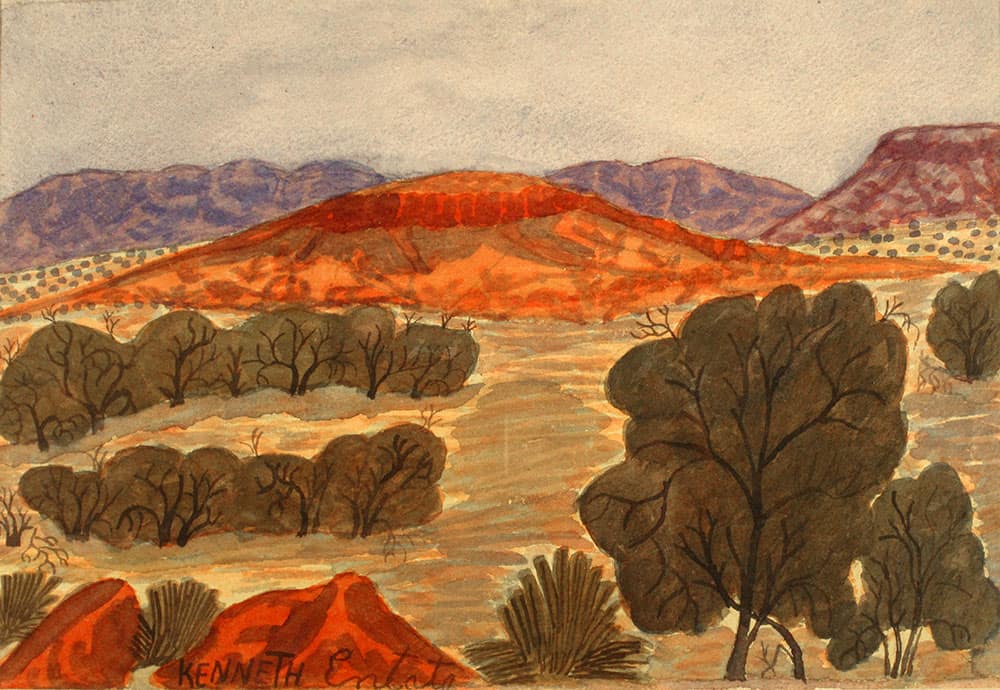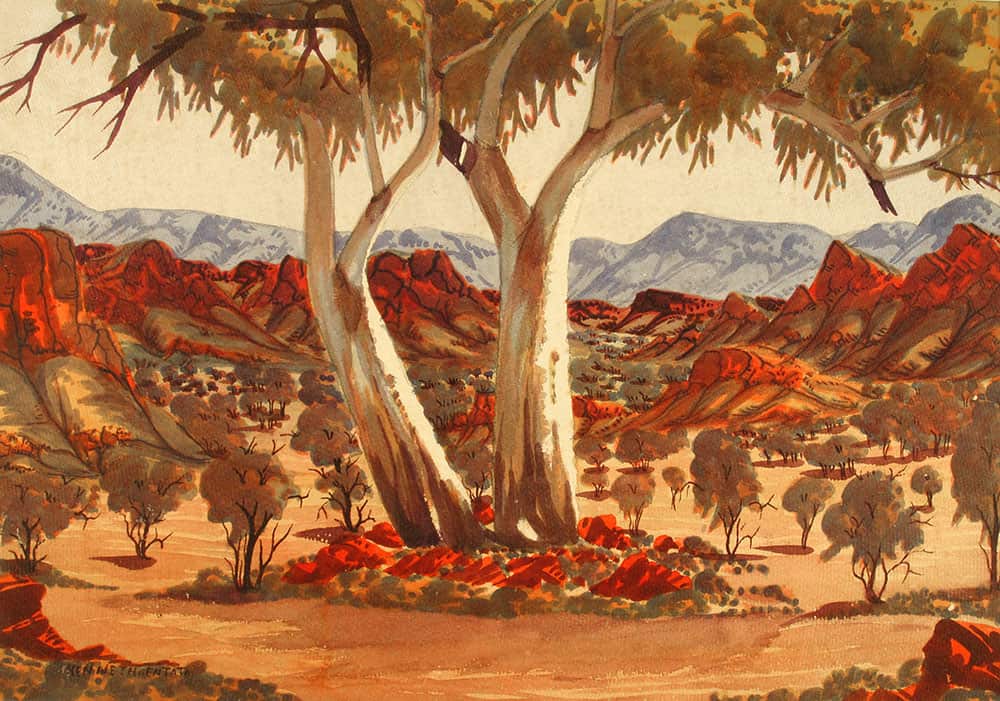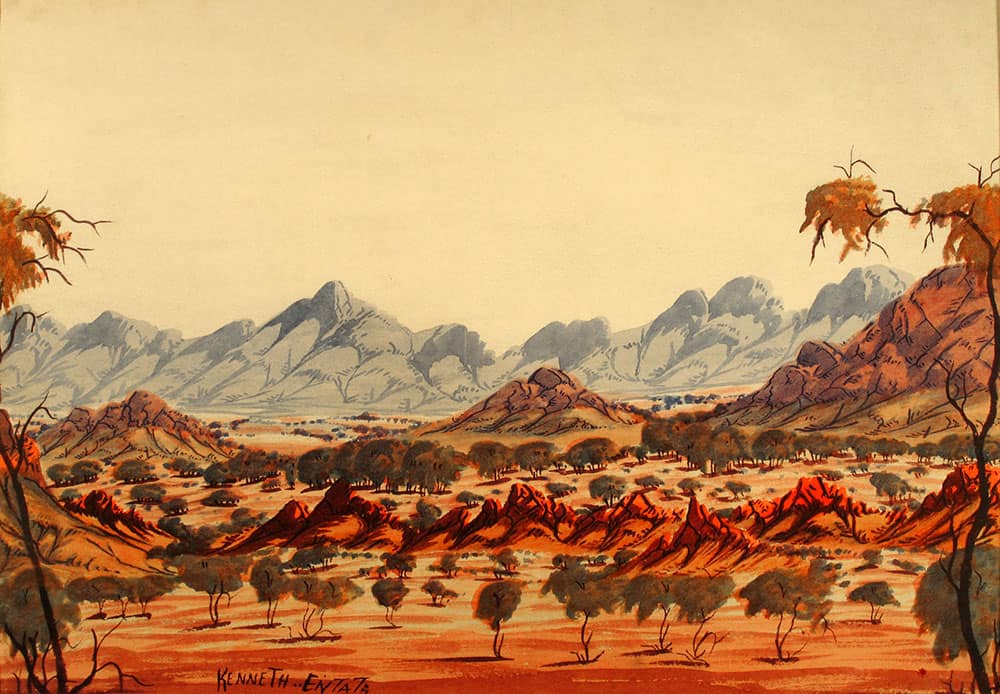1920 – 1966
Kenneth Entata painted to convey visually something of his deep love of country and, in a gentle message, to awaken empathy for traditional life as he experienced it. He seemed to invite visits to the country he portrayed, while consciously encouraging viewers to be sensitive in their thinking and approaches into country.
He was a fine painter, as demonstrated in the small number of paintings collected by the author. He was an interesting painter but he was not prolific. Kenneth Entata clarified the ideals of the Hermannsburg School. His paintings suggest that he was thoughtful about the condition of life of the Arrernte people and that he was sensitive to tradition (both Arrernte and Christian), such as the importance of choosing the ‘right way’ for visitors to approach and live in this totemic country. He helped consolidate the watercolour movement both as an artist and as a leader in cross cultural relations.
The artist was born at Hermannsburg. He was the son of Rolf and Millicent Entata. The Entata family were Eastern Arrernte who lived on the Roulbmaulbma estate as guests of the Ebatarinja group. [1] Kenneth Entata became an evangelist. [2]
His sister Irene Mbitjana Entata became a prominent Hermannsburg potter in the 1990s. Kenneth Entata started to paint seriously in 1949. Kenneth painted from around 1949 to around 1970–75 on occasions when he ‘gave voice’ to his sentiments.

Red Plain
Kenneth Entata
• • •
est. 1949-50
Watercolour on paper
24 x 35 cm
Beverley Castleman Collection
BDC-KEn-03
This early composition is a naïve fantasy. The painting has a pale yellow under wash, as if the artist was influenced by Edwin and Albert. However, the earth was portrayed as reddish, the colour of the soil. There is a glimpse of narrow yellow areas on near the central red hill. There is the usual Hermannsburg School style pencil outline of hills and foreground rocks. The dark foliage of trees was painted as massed areas of dark green. The central red hill has a dotted infill pattern on top and is portrayed in front of a yellow plain with dot infill. Ultramarine was used on the sky and rear hills. Some equivalence is suggested in the composition with the central hill and the big tree at right balancing the trees at left.

The gap through the gums
Kenneth Entata
• • •
est. 1957-59
Watercolour on paper
36.5 x 51.5 cm
Beverley Castleman Collection
BDC-KEn-02
Unusually for Hermannsburg painters, Kenneth graciously invited the viewer to step into the foreground space of his country and then to consider alternative paths to take around the imposing pair of trees. The trees were positioned centrally to intervene in the assumed straight line of sight toward the idyllic totemic valley beyond. Symbolically, the gap between the trees is screened with foliage.
This is more than just a scene of beautiful country, but perhaps an assertive trigger for visitors to acknowledge the privilege of entry before barging forward thoughtlessly.
The way around the trees is divided to one side or the other of the rocky outcrop on which the trees dominate access. Branches provide an inviting archway over each choice. The viewer can pause and consider whether to ‘go’ around the trees to either the left or to the right. The front plain on which the trees stand, gives way to a rear plain which slopes down to the right. Crimson peaked hills surround the plain.
The plain is coloured a warm cream. Yellow backlights the big tree foliage. The ground looks luminous with mauve over painting of shadows, over soft orange. White of trunks is unpainted paper. Fine dark line painting describes mid ground red hills.

The Plains
Kenneth Entata
• • •
est. 1963-73
Watercolour on paperboard
38 x 53 cm
Beverley Castleman Collection
BDC-KEn-05
The three rows of hills seem to be in gentle movement and there are no jagged edges. The two groups of dark trunked small trees of the front and mid-ground plains also seem to move as if in a slow dance. However, the two dead foreground trees on each side of the composition have not regenerated. Apparent parasitic growths linger on the dead branches, suggesting the recent death of the trees.
There seems to be a statement in this eloquent, albeit downbeat, painting. Although the hills are ‘alive’ in suggested movement, the groups of trees, which may be euphemisms for small communities (divided by the low line of red hills), are all mature with no sign of fresh young trees.
The sky is pale blue with no recession. Most of plain has no lemon but the mid-ground red topped hills have orange base. Some yellow behind foliage.

Hermannsburg landscape
Kenneth Entata
• • •
est. 1970-75
Watercolour on paperboard
24 x 35 cm
Beverley Castleman Collection
BDC-KEn-04
The important hill is carefully drawn and painted. The composition is about this unusual site. There is no screening in foreground, but individual trees stand apart from each other on the foreground plain, perhaps symbolically. The base of the totemic hill is screened by lines of trees.
The distant plain is filled in with ultramarine and dark green blob trees. Cream glows through striped red/orange foreground plain. Blue flat sky and rear hill Bright red rocks top of red hill near foreground. Ultramarine fine paint lines for drawing. The placement of three small trees in the foreground is interesting.
John Kean said that the hill on the mid ground at left is ‘Anyaly’ and that the hill on the right may be ‘Ulunparru’.
REFERENCES TO EXTERNAL TEXTS
[1] Diane Austin-Broos, Arrernte Present, Arrernte Past: Invasion, Violence, and Imagination in Indigenous Central Australia, p214 [2] Diane Austin-Broos, p217
